Written by: Lostin
Compiled by: Glendon, Techub News
Key insights
On Solana, MEV operates differently than other blockchain networks, primarily due to its unique architecture and the absence of a global memory pool. Extra-protocol memory pools must be developed independently and require adoption by a majority of stakers in the network to operate effectively, which poses high technical and social barriers.
Jito ceased its public mempool service in March 2024, resulting in a significant drop in revenue. This move reduced harmful MEV behavior, but also led to the rise of alternative mempools that lacked transparency and primarily benefited select groups.
Memecoin traders are particularly vulnerable to sandwich attacks because they set a high slippage tolerance when trading illiquid and highly volatile assets. Such users are more likely to use Telegram trading bots for faster trade execution and instant notification services, and are relatively insensitive to trades being front-runners.
Marinade Finance's Staking Auction Market (SAM) uses a competitive auction mechanism where validators bid directly against each other for stake allocations through a "pay-for-stake" system. However, this mechanism has sparked controversy because it allows validators who conduct sandwich transactions to obtain more stakes through high-price bidding, thereby increasing their influence in the network.
Most of the sandwich trading activity on Solana originates from a private memory pool operated by a single entity, DeezNode. A key validator operated by DeezNode (address beginning with HM5 H6) currently holds 811,604.73 SOLs in delegated stake, worth approximately $168.5 million, and the delegated stake has experienced significant growth in the past few months.
Multiple Solana validator operators have reported receiving lucrative offers to participate in private mempools, including detailed documents outlining profit sharing and expected returns.
Jito bundles are the primary method for seekers to ensure profitable transaction ordering. However, Jito data does not cover the full scope of MEV activity; in particular, it does not capture seeker profits or activity through alternative mempools. In addition, many applications use Jito for non-MEV purposes, such as bypassing priority fees to ensure timely inclusion of transactions.
Jito has processed more than 3 billion transaction bundles over the past year, generating a total of 3.75 million SOL in tips. This activity has shown a clear upward trend, from a low of 781 SOL in tips on January 11, 2024, to 60,801 SOL on November 19.
Jito’s arbitrage detection algorithm analyzes all Solana transactions, including those outside of the Jito bundle, and has identified more than 90.44 million successful arbitrage trades over the past year. The average profit per arbitrage was $1.58, while the single most profitable arbitrage trade generated $3.7 million in gains, and these arbitrage trades generated a total of $142.8 million in profits.
DeezNode runs a sandwich trading bot on an address starting with vpeNAL. Jito's internal analysis shows that almost half of the sandwich attacks against Solana can be attributed to this program. During a 30-day period (December 7 to January 5), the program performed 1.55 million sandwich transactions, making a profit of 65,880 SOL (about $13.43 million), with an average profit of 0.0425 SOL (about $8.67) per sandwich transaction. On an annual basis, the program will generate a profit of more than 801,500 SOL per year.
Whitelisting is widely seen as a last resort to combat bad actors, but it can create a semi-permissioned and censored environment, which is in direct conflict with the decentralized philosophy of the blockchain industry. In some cases, this approach can also delay transaction processing, affecting the user experience.
The Multiple Concurrent Leaders (MCL) system offers a promising long-term solution to the pernicious MEV problem by allowing users to choose between leaders without incurring delays. If leader A acts maliciously, users can redirect their transactions to honest leader B. However, it is expected that implementing MCL will take several years of development time.
Maximum Extractable Value (MEV) is the value that can be extracted by manipulating the ordering of transactions, which includes adding, removing, or reordering transactions within a block. MEV manifests itself in different forms, but they all have one thing in common: they rely on transaction ordering. Seekers (transactors who monitor on-chain activity) attempt to strategically place their own transactions before or after other transactions to extract value.
On Solana, MEV operates differently and uniquely from other blockchain networks, mainly due to its unique architecture and the absence of a global memory pool. Features such as Turbine (for propagating state updates) and stake-weighted quality of service (SWQoS) for transaction forwarding together shape Solana's approach to MEV. Its fast streaming block production does not require reliance on external plugins or out-of-protocol auction mechanisms, which to some extent limits the scope of application of traditional methods on certain types of MEV (such as front-running transactions). In order to gain a competitive advantage, searchers will run their own nodes or work with high-stake validators to access the latest state of the blockchain in real time.
Today, the term MEV has been overused, and opinions vary on its exact definition. In fact, not all MEVs have negative effects. Due to the distributed and transparent nature of blockchain, it is generally believed in the industry that it is almost impossible to completely eliminate MEV. And those networks that claim to have eradicated MEV either lack sufficient user activity to attract searchers, or use technologies such as random block packaging, which, while seemingly mitigating the impact of MEV, may also trigger a surge in spam.
Among them, "Sandwiching" is one of the MEV types that has attracted the most attention. It is extremely disadvantageous to users. In this strategy, the searcher inserts a transaction before and after the target transaction to profit from it. Sandwiching is naturally profitable for the searcher, but it increases transaction costs and reduces the transaction execution price for ordinary users. A detailed discussion of this MEV type will be carried out in the subsequent content.
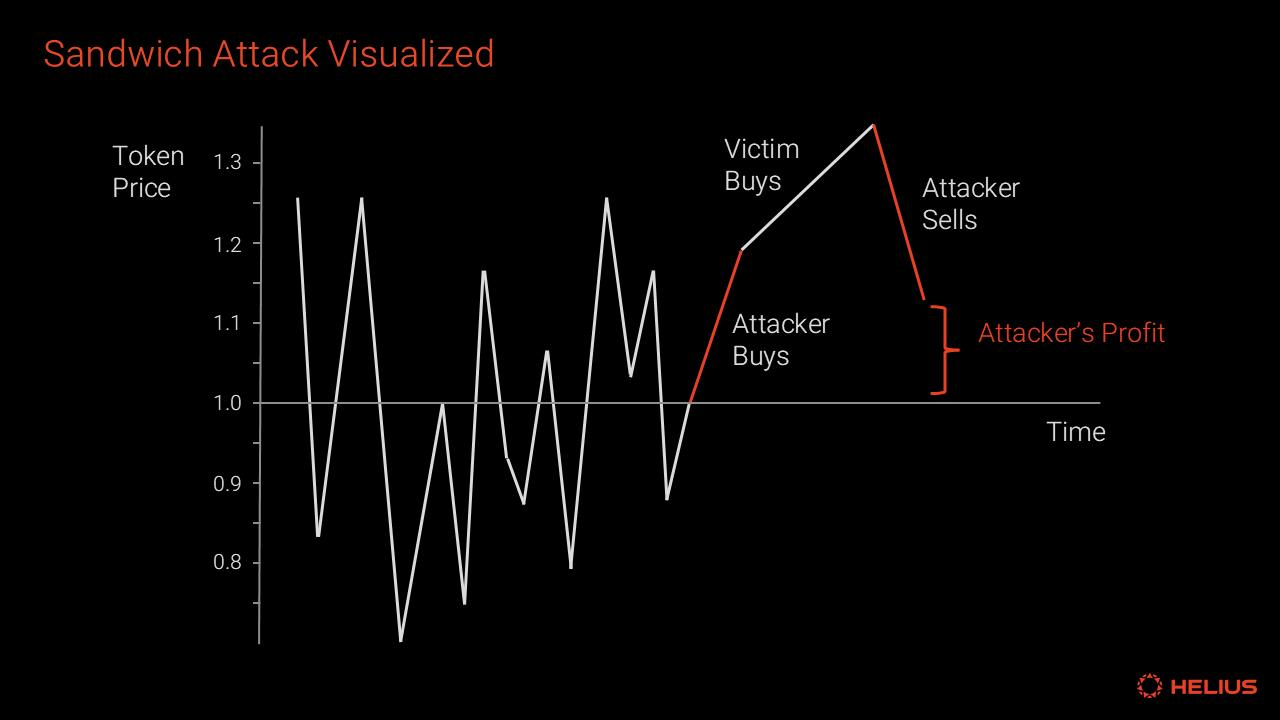
Above: Visualization of a typical sandwich attack. The attacker front-runs and tails the victim’s buy trade to make a profit.
In this report, we will analyze Solana’s current MEV landscape, which is divided into four parts:
1. Solana MEV Timeline : Outlines a series of key events in chronological order, providing valuable context for readers who are not familiar with the rapid development of MEV on Solana;
2. Types of MEVs : Explore the various types of MEVs currently observed on Solana through specific and detailed examples;
3. Solana MEV Data: Provide relevant, quantifiable, and contextual data to illustrate the current scope and impact of MEV in Solana;
4. MEV Mitigation Mechanisms : Research is considering strategies and mechanisms for reducing or eliminating harmful forms of MEV.
Solana MEV Timeline
Below is a timeline of important events related to Solana MEV.
September 2021 to April 2022: Spam and DDoS attacks
NFTs were one of the first areas to gain significant traction on Solana. MEV in the NFT space occurs primarily during public events where participants compete to acquire rare or valuable assets. These events undoubtedly create sudden profit opportunities for seekers, with no MEV potential in blocks minted before and huge MEV potential in blocks minted later. The NFT minting mechanism was one of the earliest causes of the massive congestion surge on Solana caused by spam transactions sent by bots, which overwhelmed the network and caused block production to temporarily stop.
Mid-2022: Introduction of priority fees
Solana has implemented an optional Priority Fee that users can specify in their computational budget directives to prioritize their transactions. This mechanism strengthens the network’s economic model by allowing users to pay for accelerated processing during peak activity, alleviating network congestion and establishing a more efficient framework for the fee market.
Additionally, priority fees help curb spam by changing the playing field. Bots that previously relied on brute force trading volume to gain an advantage are no longer able to dominate simply by spamming. Instead, priority is also determined by the fees users are willing to pay.
August 2022: Jito-Solana client launched
Jito has become the default Solana MEV infrastructure . The client aims to democratize MEV capture, ensuring a more equitable distribution of rewards across the network. When leaders use the Jito client validator, their transactions are initially directed to a Jito relayer, which acts as a transaction proxy router. The relayer holds the transaction for 200 milliseconds before forwarding it to the leader. This speed buffer delays incoming transaction messages, providing a window for off-chain auctions through the Jito block engine. Seekers and applications submit atomically executed transaction bundles with SOL-based tips. Jito charges a 5% fee on all tips, with a minimum tip of 10,000 lamports. (Bundles can be inspected via the Jito bundle browser .)
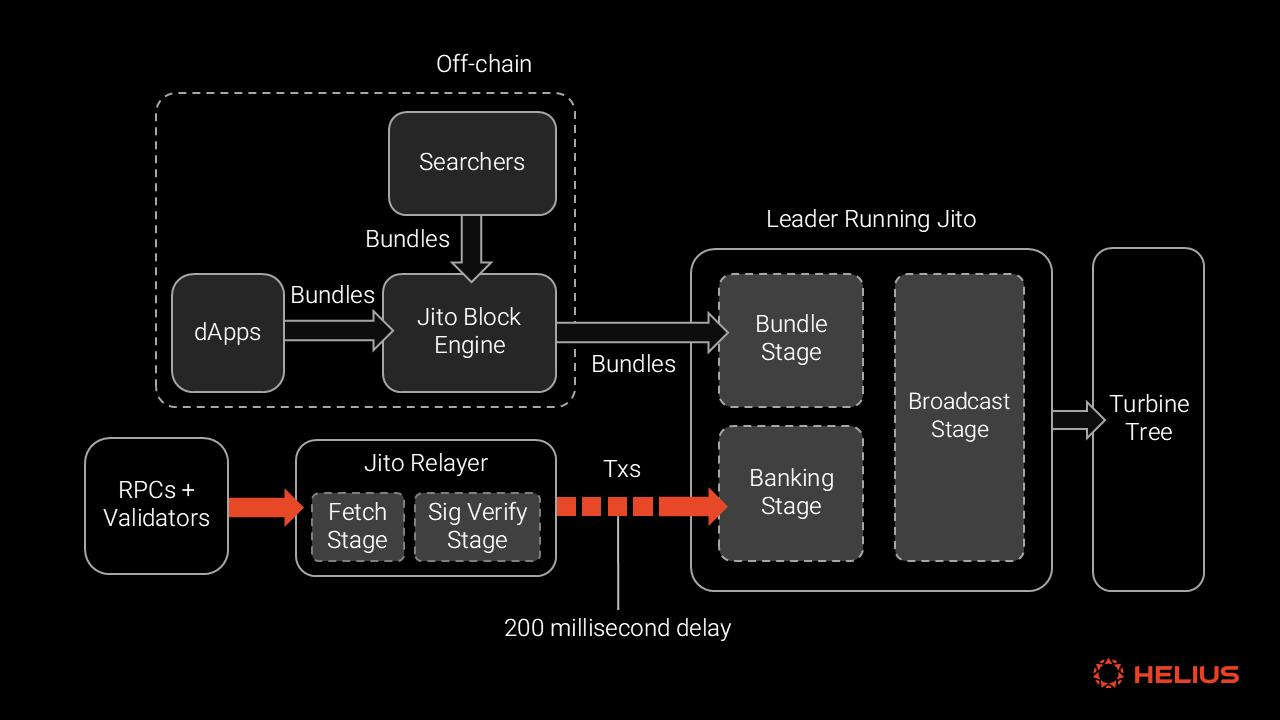
Above: The current Jito architecture consists of a block engine that accepts bundles submitted by searchers and a relayer that delays sending incoming transactions to the leader.
This approach reduces spam and improves the efficiency of Solana’s computational resources by running the auction off-chain and only publishing a single winner into a block. This is especially important considering that unsuccessful transactions can consume a large portion of the network’s computational resources.
For the first nine months, Jito-Solana client adoption remained below 10% as network activity remained low and MEV rewards were small. Starting in late 2023, adoption accelerated significantly, reaching 50% by January 2024. Today, over 92% of Solana validators (weighted by stake) use the Jito-Solana client.
January 2024: Memecoin Season Begins
In early 2024, there was a surge in network activity. Memecoins such as Bonk and DogWifHat became popular, sparking high interest from searchers and leading to a significant increase in MEV activity. This period marked a significant shift in user behavior: Memecoin traders preferred Telegram trading bots such as BonkBot, Trojan, and Photon over traditional decentralized exchanges or aggregators. These bots offered faster trading speeds, real-time notifications, and an intuitive user interface that attracted retail speculators. Notably, these traders were often willing to set higher slippage rates to ensure that time-sensitive trades were prioritized, and were relatively indifferent to their trades being front-loaded.
March 2024: Jito suspends its flagship Mempool feature
Jito's Mempool provides a 200 millisecond window for searchers to preview all incoming leader transactions. During its operation, the system was often used for Sandwich Attacks, which severely degraded the user experience. In order to prioritize the long-term growth and stability of the network, Jito made a controversial decision to suspend its Mempool, sacrificing significant revenue in the process. While the move received widespread support, it was also criticized by several prominent figures, including Mert Mumtaz and Jon Charbonneau.
The main risk of this decision is that alternative mempools could emerge that replicate Jito’s functionality, allowing for more harmful forms of MEV. This is because unlike public mempools, which promote a fairer distribution of MEV opportunities and mitigate power imbalances within the network, private permissioned mempools lack transparency and only benefit the few who have access.
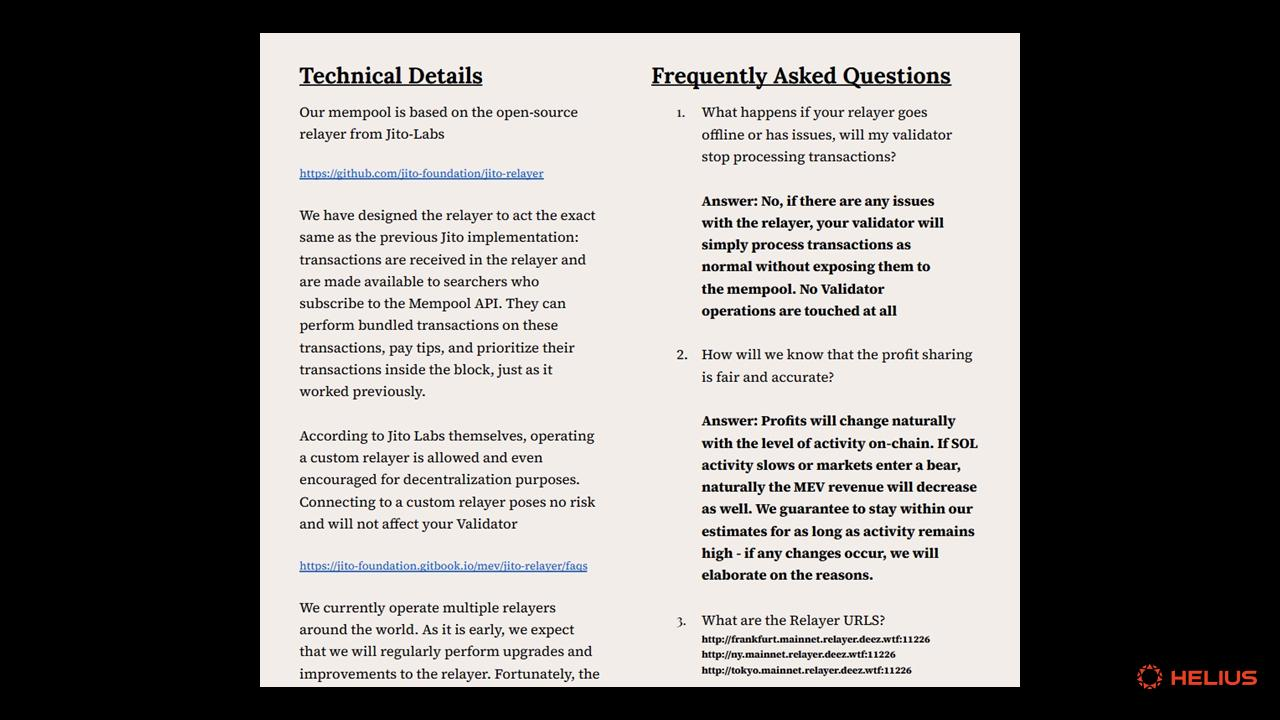
Above: Part of the DeezNode MEV proposal regarding “DeezMempool.” Shortly after the Jito Mempool was suspended, multiple validators reported receiving the DeezNode MEV proposal.
Multiple Solana validator operators reported receiving lucrative offers to participate in private mempools .
May 2024: New transaction scheduler
As part of the Agave-Solana 1.18 update , the new Scheduler significantly improves Solana's ability to order transactions in a deterministic manner. The improved scheduler can better prioritize transactions with higher fees to increase their likelihood of being included in a block. The central scheduler builds a dependency graph called a "prio-graph" to optimize the handling and prioritization of conflicting transactions across multiple threads.
Previously, bots engaging in arbitrage and other MEV activities were incentivized to improve their chances of successful execution by spamming leaders. The randomness of the old scheduler led to variability in the placement of transactions within blocks. However, the new deterministic approach reduces this randomness, inhibits spam, and improves the overall efficiency of the network.
June 2024: Marinade launches the Staking Auction Market (SAM)
Marinade Finance's Staking Auction Market (SAM) uses a bidding auction mechanism in which validators bid directly against each other for stake allocations through a "pay for stake" system. This structure incentivizes validators to bid to the highest rate they think is profitable. However, the mechanism has been controversial because it allows validators who engage in sandwich transactions to obtain more stakes through high-priced bidding, thereby increasing their influence in the network. Marinade Labs recently proposed the establishment of a public committee to oversee delegation behavior . After Jito, Marinade Finance's mSOL has become the second largest liquid staked token and staked pool on Solana.
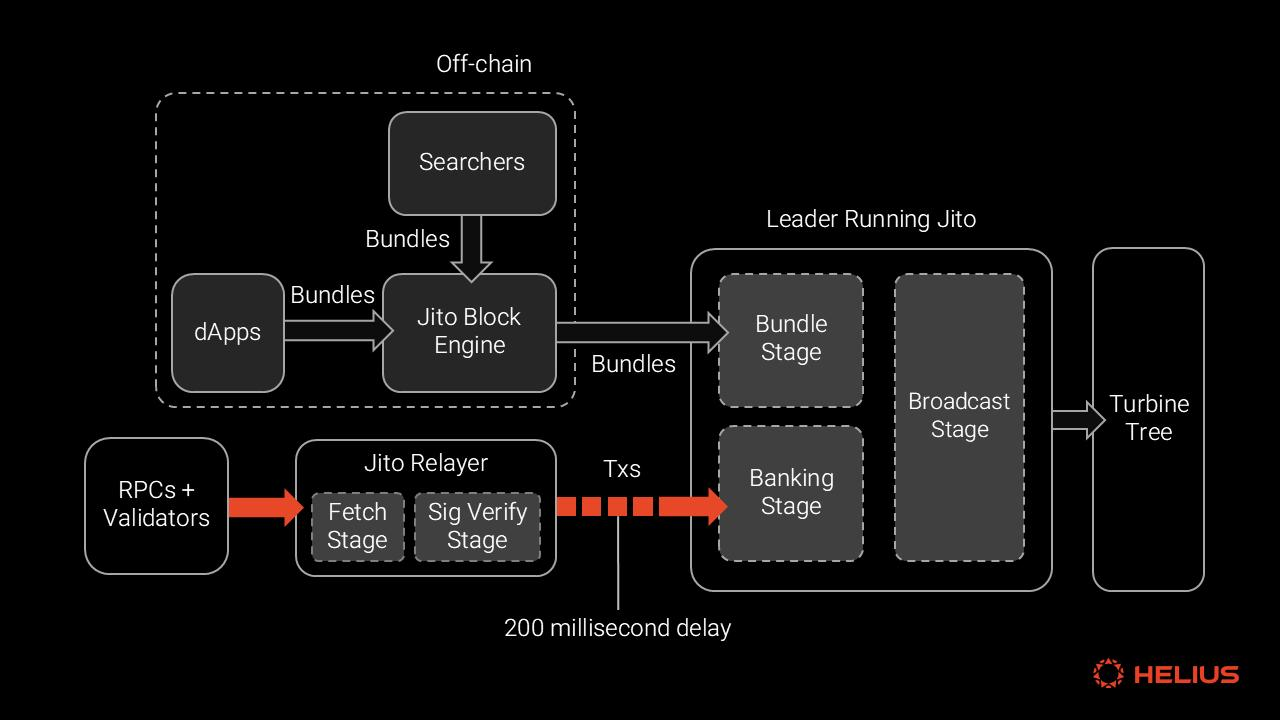
Above: Pledge auction situation in Marinade Finance pledge auction market (December 27, 2024)
As of epoch 717, validators with 0% staking commissions and 0% MEV commissions typically offer stakers an APY of about 9.4%. Validators that use out-of-protocol methods to redistribute block rewards typically offer an APY of 10% or less. In comparison, Marinade's SAM auction showed a winning APY of 13.73%, with the top ten validators bidding as high as 18.27% APY.
This discrepancy suggests that these validators are either bidding improperly and losing money as a result (they may be subsidizing their bids through stake delegation from the Solana Foundation) or supplementing their income through other sources such as MEV extracted from user sandwich transactions.
December 2024: Concerns grow about new private mempools
After Solana research firm Temporal publicly expressed concerns about the potential centralization of network staking , Solana MEV became a controversial topic, sparking widespread discussion and once again prompting the ecosystem team to address the challenges posed by Solana MEV.
Validators that engage in harmful MEV extraction receive value disproportionate to their contributions, causing their stake to grow much faster than other validators. This allows validators to accumulate greater network influence over time, which introduces centralization risks to Solana’s validator economics. These higher-yielding validators can also offer higher returns to stakers, thereby attracting more stakes and further expanding their dominant position.
It is important to note that the majority of Solana’s sandwich trading activity originates from a private memory pool operated by a single entity, DeezNode. A key validator operated by DeezNode (address beginning with HM5H6) currently holds a delegated stake of 811,604.73 SOL, worth approximately $168.5 million. The delegated stake of this validator has experienced a significant increase, from 307,900 SOL on November 13 (epoch 697) to 802,500 SOL on December 9 (epoch 709), and has since stabilized. It is worth mentioning that 19.89% of the stake comes from Marinade’s mSOL liquid stake pool and Marinade’s native delegation. The validator currently holds 0.2% of the total stake (currently 392.5 million SOL), ranking 93rd by stake in the wider set of validators.
Jito’s internal analysis shows that an increasing number of sandwich attacks occur outside of Jito’s auction mechanism, suggesting the presence of additional block engines or modified validator clients conducting such transactions.
Types of MEVs
Next, let’s look at the various MEV types on Solana and illustrate each type with specific examples of actual transactions. Below are the most common MEV transaction types currently observed on Solana.
Liquidation
When a borrower fails to maintain the required collateralization ratio for their loan on a lending protocol, their position becomes eligible for liquidation. Seekers monitor these undercollateralized positions on the blockchain and perform liquidations by paying off some or all of the debt in exchange for a portion of the collateral as a reward. Liquidations are considered a benign type of MEV. They are critical to maintaining protocol solvency and promoting stability in the broader DeFi ecosystem.
Clearing Transaction Example
This liquidation event occurred on December 10th and involved Kamino, the largest lending protocol on Solana by liquidity and user base. The transaction consisted of three steps:
Seeker initiated the liquidation by transferring 10.642 USDC to the Kamino reserve to cover the user’s debt position.
In exchange, Kamino Reserve transfers the user’s 0.05479 SOL collateral to the Seeker.
The searcher paid a protocol fee of 0.0013 SOL.
In addition, the searcher paid a priority fee of 0.001317 SOL for this transaction, resulting in a net profit of $0.0492.
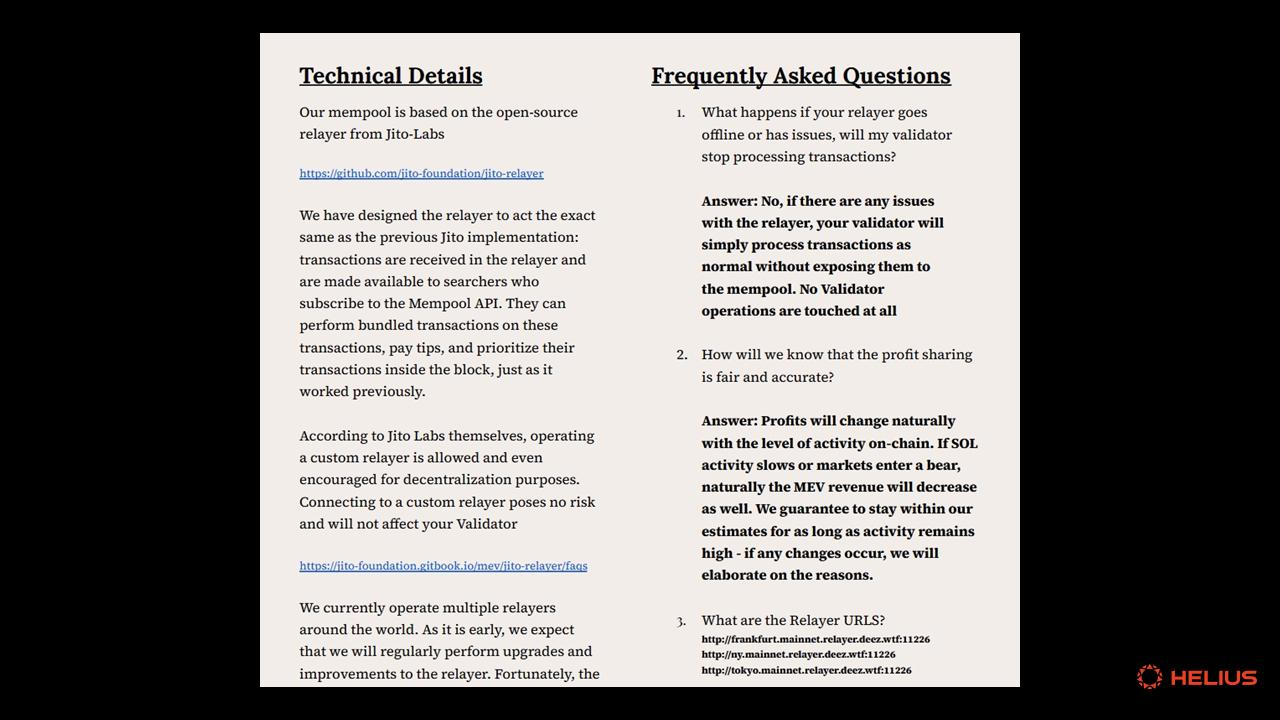
Above: An example of a liquidation transaction on Solana’s Kamino money market.
arbitrage
Arbitrage improves market efficiency and profits by adjusting prices across different trading venues to exploit price differences for the same asset. These opportunities can occur within a chain, across chains, or between centralized and decentralized exchanges (CEX/DEX arbitrage). Among them, intra-chain arbitrage guarantees atomicity because the two parts of the transaction can be executed together in a single Solana transaction. In contrast, cross-chain and cross-platform arbitrage introduces additional trust assumptions.
Atomic arbitrage is the primary form of MEV on Solana. The simplest example of atomic arbitrage occurs when two DEXs list different prices for the same trading pair. This typically involves taking advantage of outdated price information on a constant product model (xy=k) automated market maker (AMM) and hedging on the chain limit order book, where the market maker has adjusted its quote based on off-chain price changes.
Arbitrage Trading Example
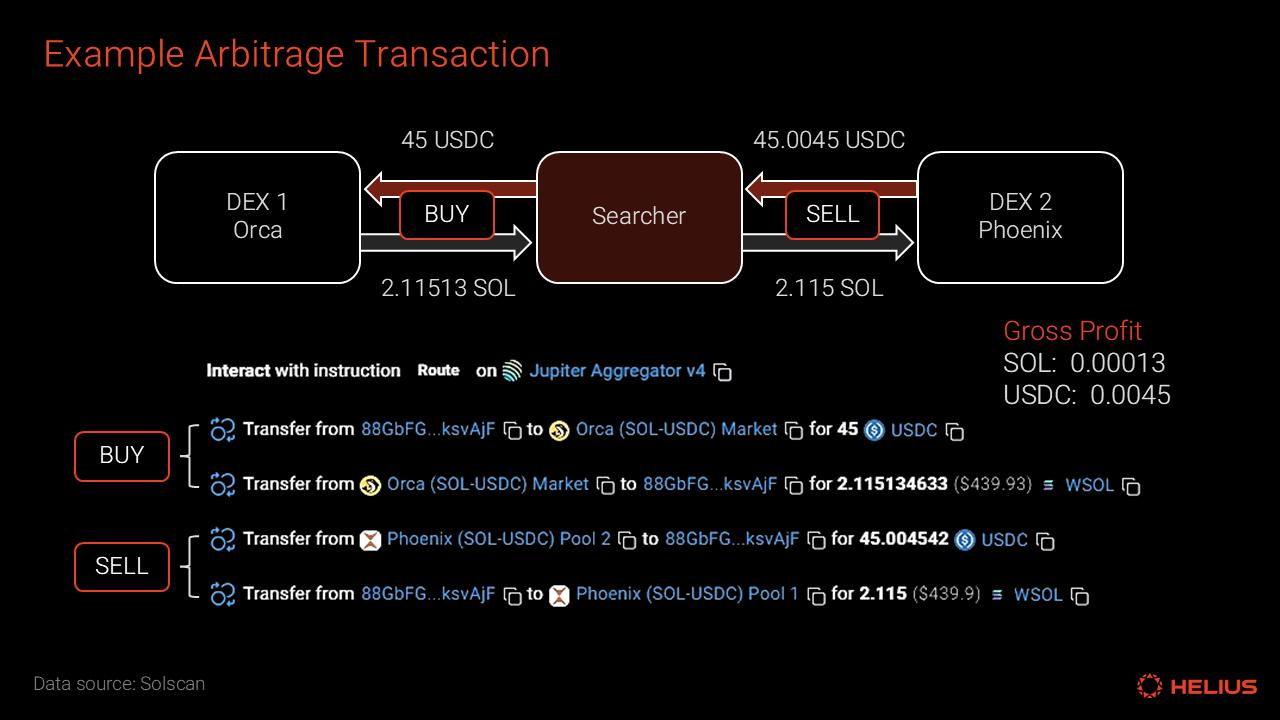
Above: Example of arbitrage trading between two decentralized exchanges
In this case, the price of the SOL/USDC trading pair has changed off-chain, prompting Phoenix market makers to update their quotes accordingly. Meanwhile, Orca AMM is still quoting based on outdated prices, creating an arbitrage opportunity for the seeker. The seeker bought 2.11513 SOL for 45 USDC on Orca, and then sold 2.115 SOL for 45.0045 USDC on Phoenix, making a profit of 0.00013 SOL (about $0.026). Arbitrage trades are executed atomically, without the need for the seeker to hold inventory. The only risk is that if the trade is reversed, there may be associated fees.
Front-runner trading
Front running occurs when a MEV seeker identifies another trader’s buy or sell order in the memory pool and places the same order before that trader, profiting from the price impact of the victim’s trade.
Front-running occurs when an observer notices that an unconfirmed transaction could affect the price of a token and acts on this information before the original transaction is processed. This strategy is simple and straightforward and does not involve the complexity of other methods such as sandwich attacks.
The searcher realizes that there is a pending buy trade that will have a positive impact on the target token price, so it bundles its buy trade with the target trade. Their order will be processed at a price lower than the target, and once the target trade is completed, they will make a profit. In the process, the target trader will suffer losses due to the MEV searcher's buy trade, which causes them to buy at a higher price.
Trailing Trading
Back Running is the counterpart of Front Running. It is a specific MEV strategy that takes advantage of a temporary price imbalance caused by another transaction, which is usually caused by improper routing. Once the user's transaction is executed, the back running searcher will balance the prices of various fund pools by trading the same asset and ensure profit. In theory, the user could have obtained this part of the profit through more efficient transaction execution.
Trailing Transaction Example
This famous tailing transaction occurred on January 10, 2024, when a user purchased $8.9 million worth of DogWifHat tokens WIF in a single transaction. At the time, the WIF token was trading at $0.2, and the liquidity of all on-chain trading venues combined was only a few million dollars. The Jupiter aggregator executed the transaction through three limited liquidity pools, causing the price to surge to $3.
The searcher performed a trailing trade using the Jito Bundle and provided a generous Jito tip of up to 890.42 SOL ($91,621). They first exchanged 703.31 SOL ($72,368) for 490,143.90 WIF tokens through a Raydium centralized liquidity pool. They then exchanged these WIF tokens for 19,035.97 SOL ($1,958,733) through the Raydium V4 liquidity pool. This series of operations netted a net profit of 17,442.24 SOL ($1,794,746) in a single transaction. All USD values reflect the price at the time of the transaction.
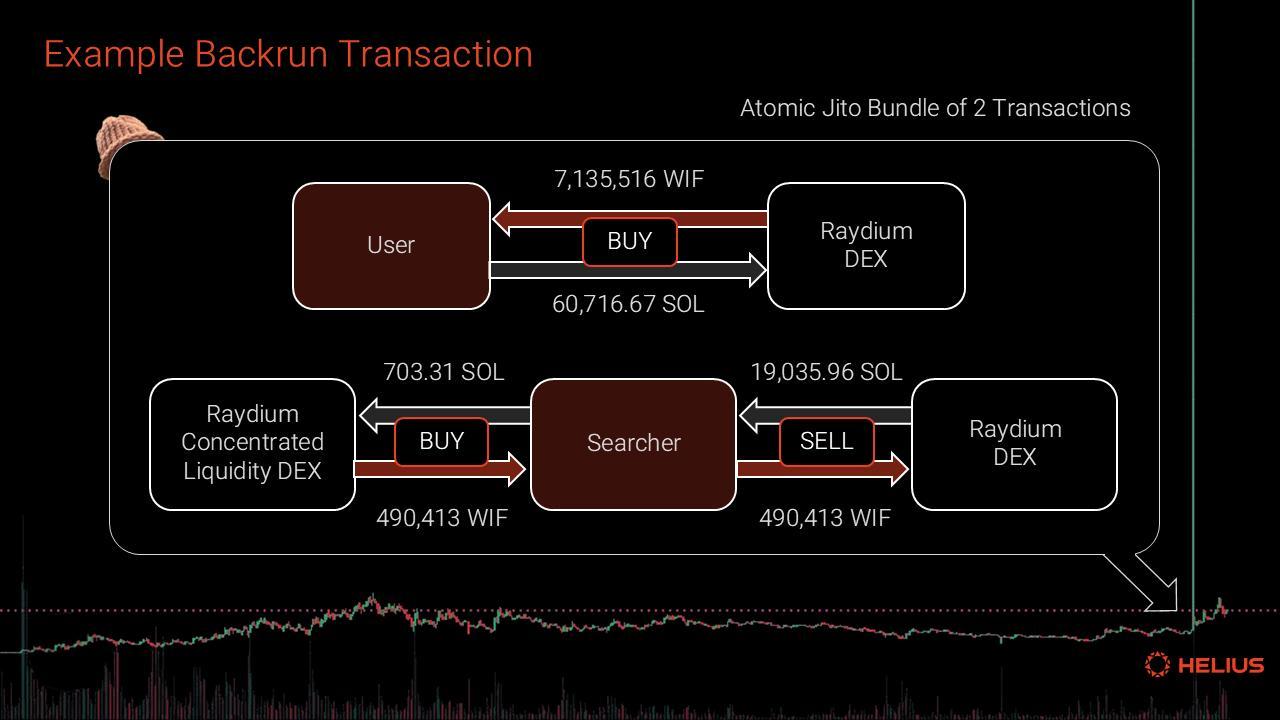
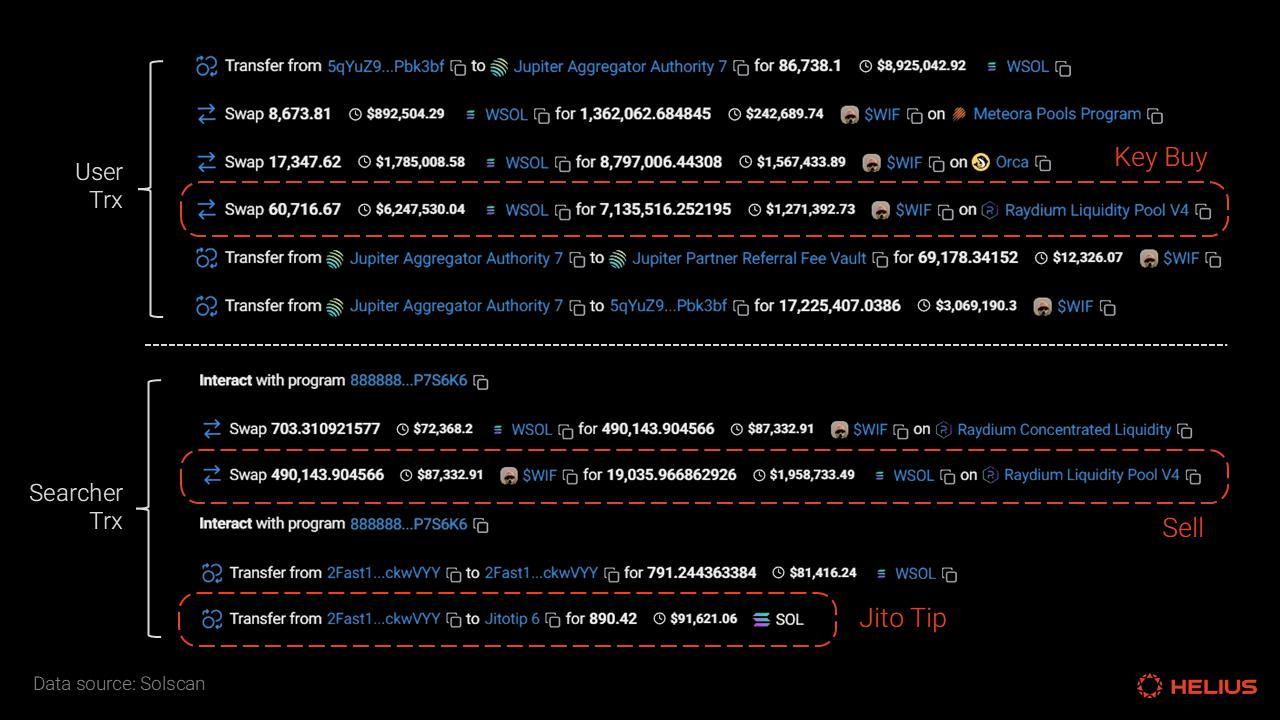
Above: Trailing transactions after a large purchase of WIF tokens in January 2024
Sandwich attack
Sandwich Attacks are one of the most destructive types of MEV, specifically targeting traders who set high slippage tolerance on automated market makers (AMMs) or bonding curves. These traders increase their slippage tolerance not to accept worse prices, but to ensure that orders can be executed quickly. Memecoin traders are particularly vulnerable to sandwich attacks because they tend to set high slippage tolerance when trading assets with poor liquidity and high volatility, which ultimately leads to them trading at extremely unfavorable prices.
A typical sandwich attack involves three atomically bundled trades. First, the attacker executes an unprofitable front-running trade, buying the asset to push its price up to the worst execution level allowed by the victim's slippage settings. Next, the victim's trade occurs, and since it is executed at an unfavorable price level, the price increases further. Finally, the attacker completes a profitable trailing trade, selling the asset at an inflated price, thereby offsetting his initial losses and making a net profit.
Sandwich attack transaction example
The attack took place on December 16, 2024, using a well-known sandwich attack program (vpeNALD… Noax38b). The searcher submitted the transactions as atomic Jito bundles and paid a tip of 0.000148 SOL (about $0.03).
First-come-first-served deal: Seekers paid 14.63 SOL to buy 32.9 million Komeko tokens, a new Memecoin on the Pump Fun platform;
Victim transaction: 0.33 SOL was used to purchase 624,000 Komeko tokens;
Trailing Transaction: Seekers are selling 32.9 million Komeko tokens at 14.65 SOL.
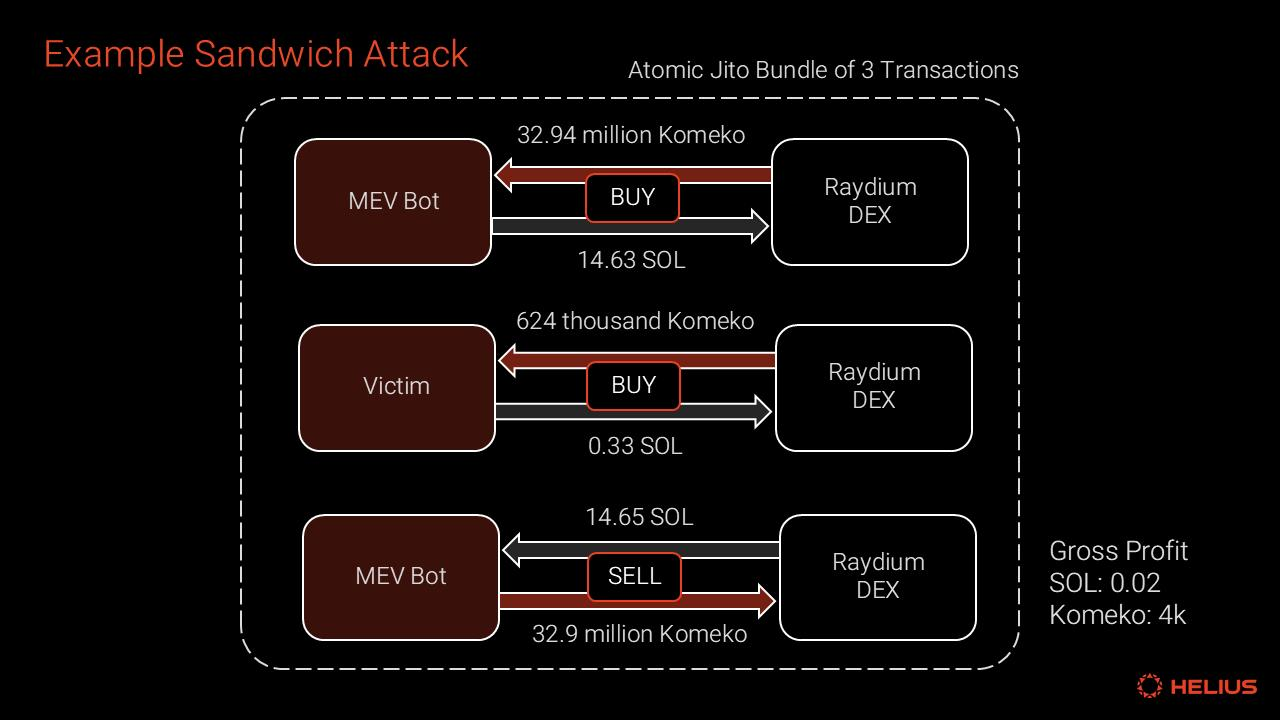
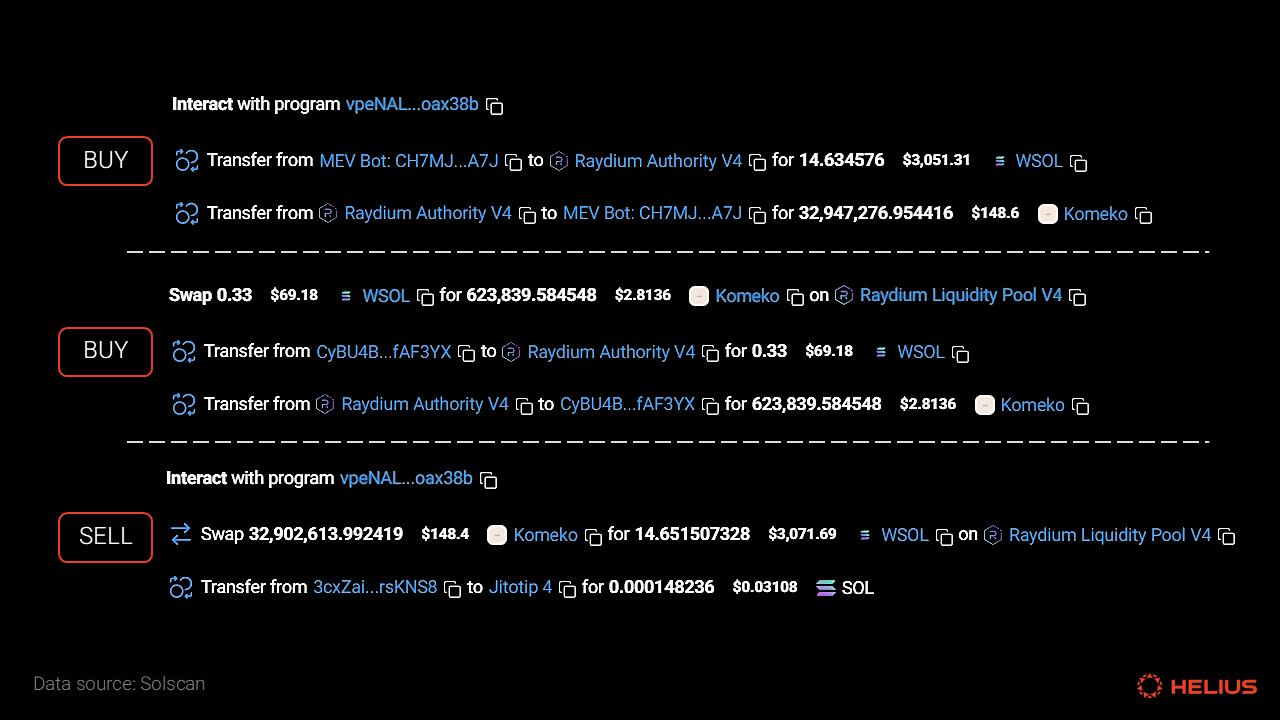
Above: An example of a sandwich attack that bundles three transactions together
Features that indicate this is a sandwich attack:
The signers of the intermediate transactions are different from the signers of the first and last transactions.
The tokens purchased in the first two transactions are the same tokens sold in the third transaction.
The token traded is a newly minted, illiquid and highly volatile Pump Fun token.
The searcher made a net profit of 0.01678 SOL, which was approximately equivalent to $3.35 at the time of the transaction.
Solana MEV Data
This section evaluates the current Solana MEV profile using existing public data. It begins with an analysis of Jito’s performance metrics, followed by an in-depth look at the number of reverted transactions and the breakdown of arbitrage profitability. It ends with a case study detailing the behavior and profitability of a well-known sandwich trading bot.
Jito
Jito bundles are the primary method for searchers to ensure profitable transaction ordering. Most Jito tips come from users who want to be among the first to buy tokens or take advantage of opportunities to be at the top of blocks. However, Jito data does not cover the full scope of MEV activity; in particular, it does not capture searcher profits or activity through alternative memory pools. In addition, many applications use Jito for non-MEV purposes, bypassing priority fees to ensure timely inclusion of transactions.
Data from transfers to eight designated Jito tipping accounts shows that Jito has processed more than 3 billion transaction bundles over the past year, generating a total of 3.75 million SOL in tips. This activity has shown a clear upward trend, from a low of 781 SOL on January 11, 2024, to a high of 60,801 SOL and 60,636 SOL on November 19 and 20, respectively. From the chart, there was a clear slowdown in the third quarter, with tips falling to a low of 1,661 SOL on September 7. In addition, the value of tips before December 2023 is negligible compared to the significant growth throughout 2024.
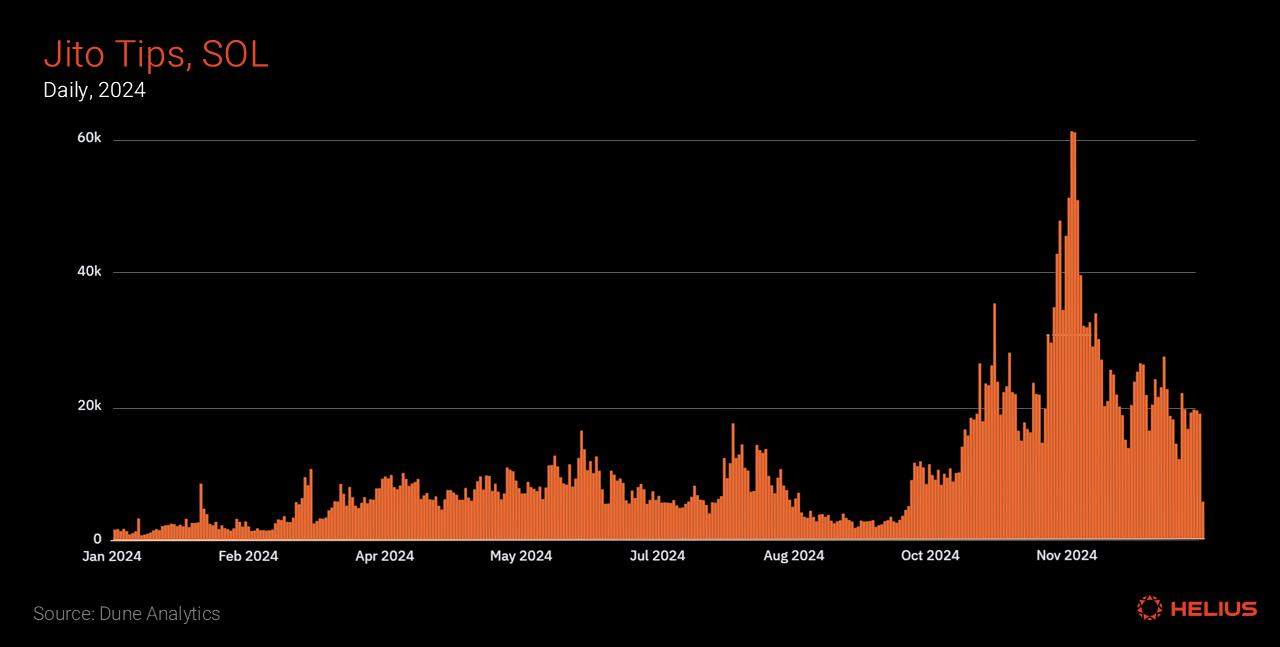
Above: Daily amount of Jito tips in SOL (data source: Dune Analytics, 21co)
The number of bundles processed through Jito continued to grow throughout 2024, ultimately peaking at 24.4 million bundles on December 21. This growth included two notable surges. The first surge occurred between May and early July, with the number of daily bundles increasing from approximately 3 million to 12 million, likely in response to network congestion issues. The second surge occurred between November and December, with the number of daily bundles doubling from approximately 12 million to a peak of 24 million.
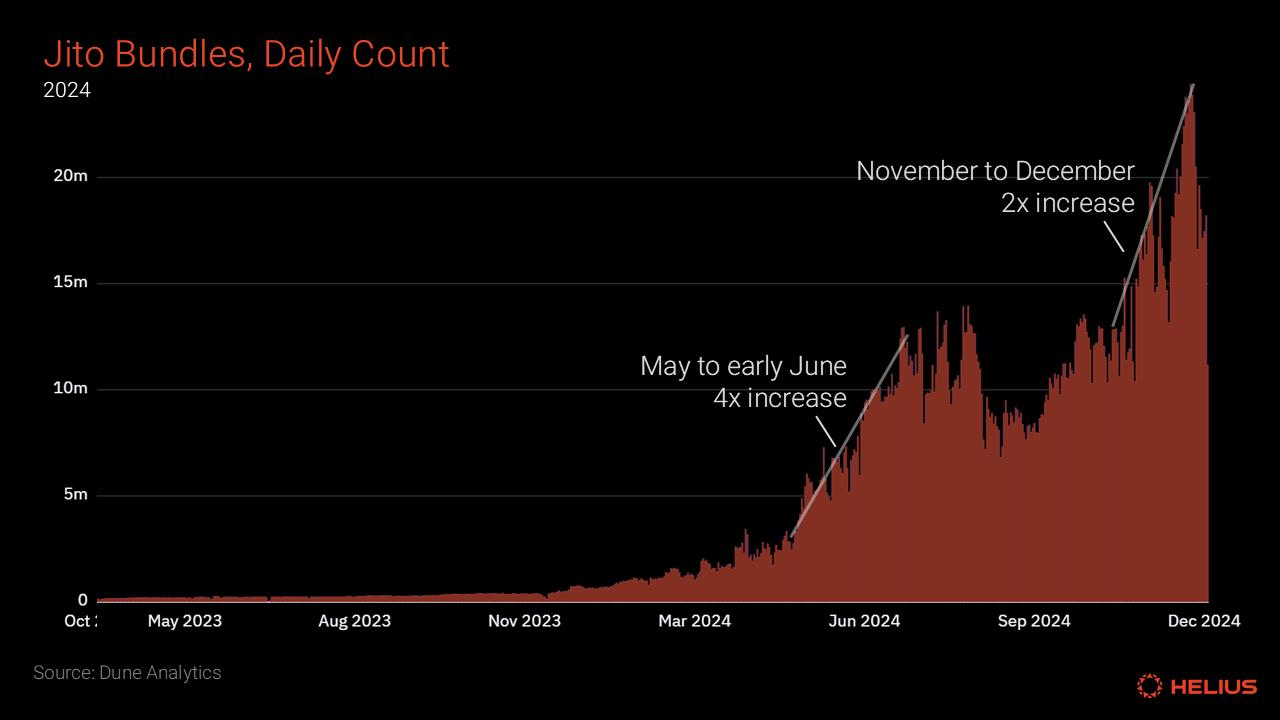
Above: Daily number of Jito tips (bundles) throughout 2024 (data source: Dune Analytics, Andrew Hong)
The number of accounts using Jito also showed a parallel upward trend during this period, with about 20,000 daily tip payers at the beginning of the year and a peak of nearly 938,000 on December 10. Notable growth periods included a six-fold increase from 21,000 in early March to 135,000 in mid-April, and a sharp increase from 208,000 in October to 703,000 by the end of the month (a 3.4-fold increase).
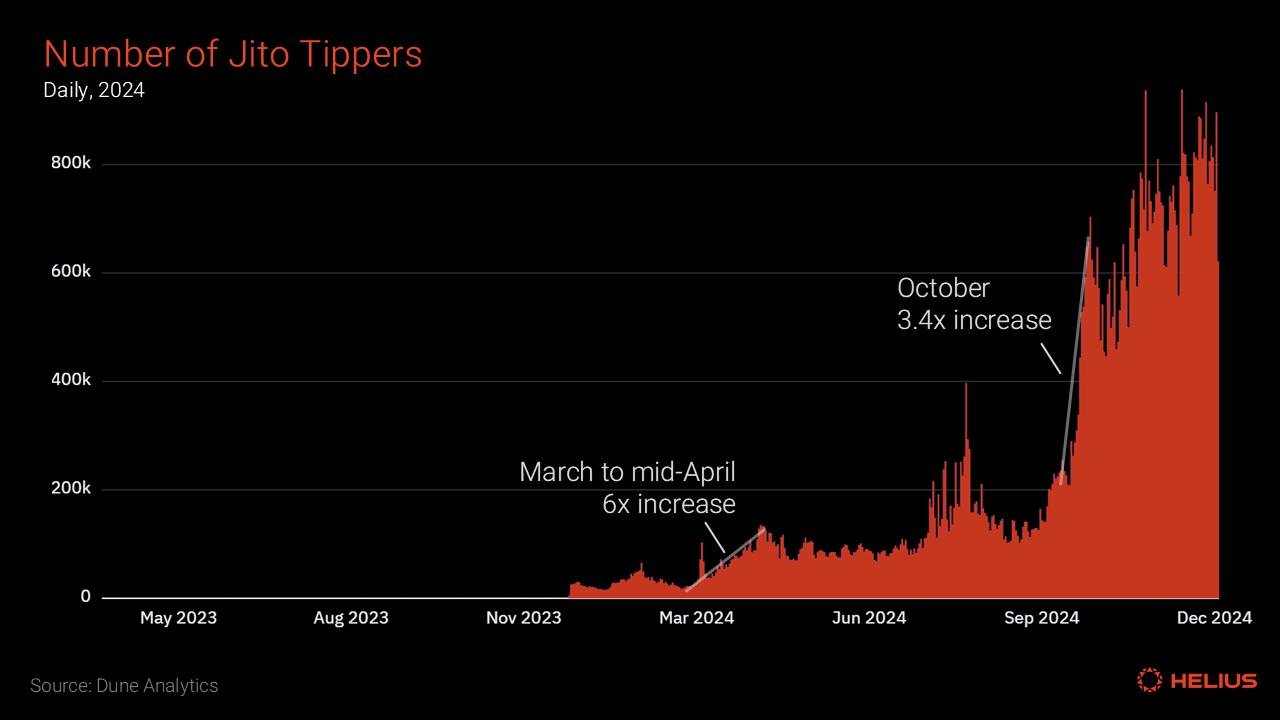
Above: Number of daily tip payers on Jito (data source: Dune Analytics, Andrew Hong)
Throughout 2024, the percentage of validators using the Jito-Solana client has steadily increased, reinforcing the effectiveness of the Jito bundle for fast transaction inclusion. At the beginning of the year, validators using the Jito-Solana client staked 189.5 million SOL, accounting for 48% of the total stake on the network. By the beginning of 2025, this number had increased to 373.8 million SOL, accounting for 92% of the total stake.
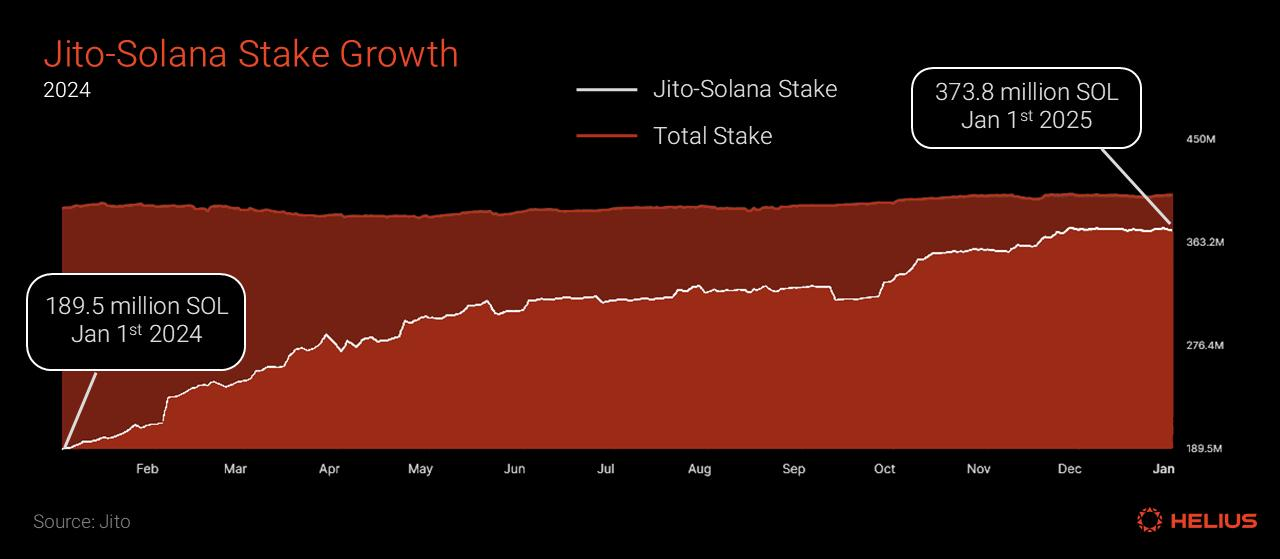
Above: Jito-Solana validator adoption growth by stake in 2024 (Source: Jito)
Reversing a transaction
A large portion of transactions on Solana are related to MEV extraction related spam. By examining the ratio of reverted transactions to successful transactions, we can identify patterns that indicate MEV bots are racing to capture arbitrage opportunities.
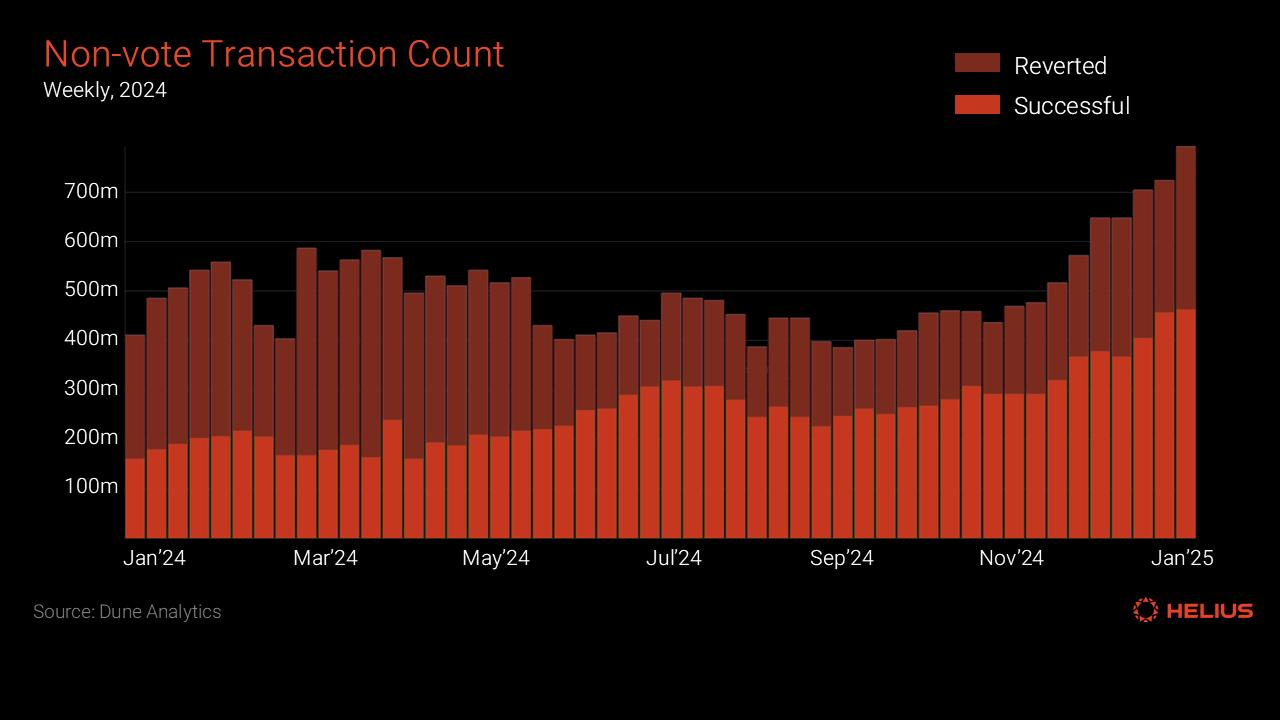
Above: Number of revoked and successful non-voting transactions per week in 2024 (data source: Blockworks Research)
Spam poses a significant challenge because it causes many transactions to be revoked. Under the winner-take-all nature of MEV, only one transaction can take advantage of a given opportunity. However, even after the opportunity is captured, the leader will still process other transactions attempting to take advantage of the same opportunity. These revoked transactions still consume valuable computing resources and network bandwidth. Competitive latency races between searchers further exacerbate this problem, causing the network to be flooded with duplicate transactions, which in extreme cases can also cause congestion and a degraded user experience. Due to Solana's low transaction costs, revoked arbitrage spam still has a positive expected value. Over time, traders can achieve profitability by executing these trades at scale (even though individual transactions may fail).
Reversed transactions peaked in April 2024, accounting for 75.7% of all non-voting transactions. This percentage has dropped significantly after the rollout of key updates including the Agave 1.18 central scheduler. The new scheduler improves deterministic transaction ordering within the “Banking Stage”, thereby curbing the effectiveness of spam.
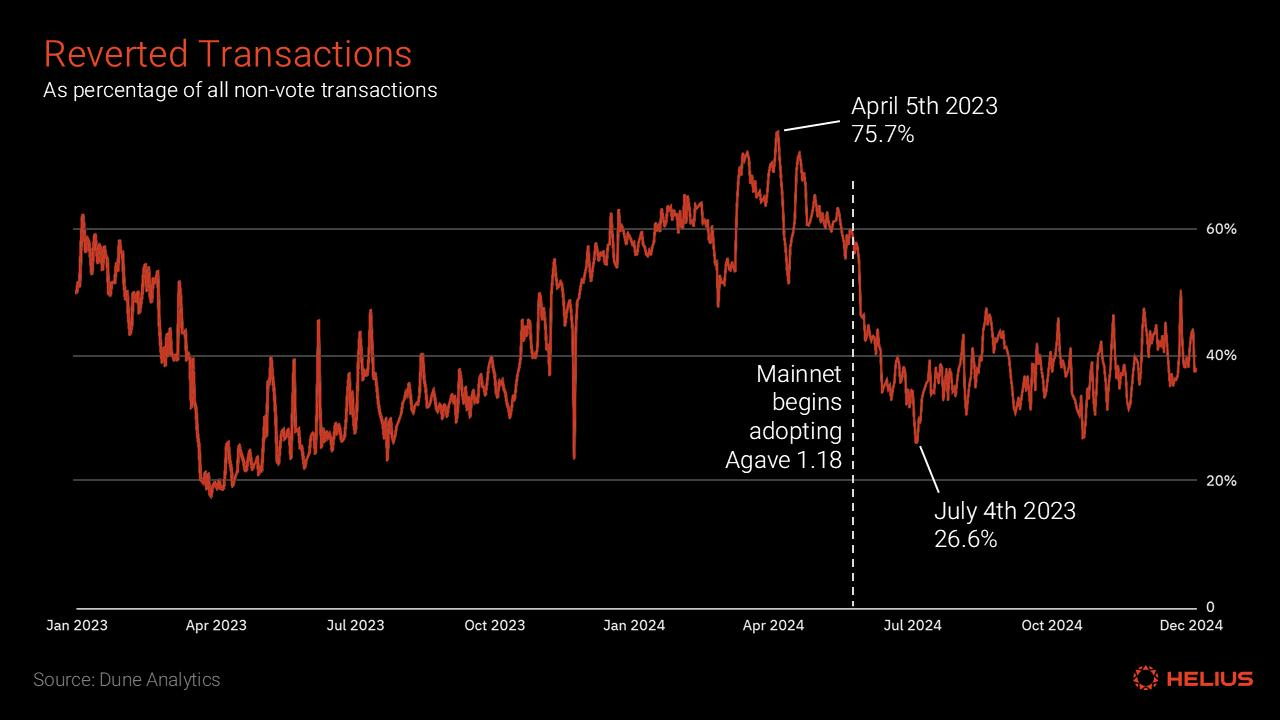
Above: The percentage of revoked transactions as a percentage of all non-voting transactions (data source: Dune Analytics, 21co)
Arbitrage Profitability
Jito’s arbitrage detection algorithm analyzed all Solana transactions, including those outside of the Jito bundle, and identified 90,445,905 successful arbitrage trades over the past year. The average profit per arbitrage was $1.58, and the single most profitable arbitrage trade generated $3.7 million in gains. These arbitrage trades generated a total of $142.8 million in profits, of which $126.7 million (88.7%) was denominated in SOL.
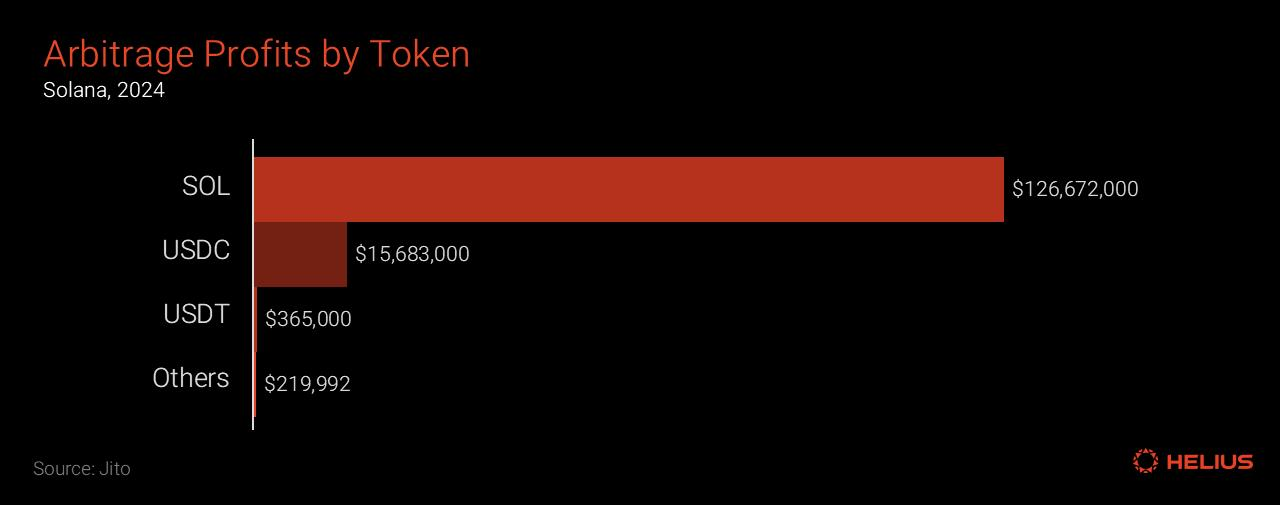
Above:Arbitrage trading profits by token in 2024 (data source: Jito)
Case Study: Vpe Sandwich Trading Program
DeezNode runs a sandwich trading bot on the address beginning with vpeNAL as part of its alternative mempool operations. This highly active program has recently gained notoriety for executing large-scale user sandwich attacks.
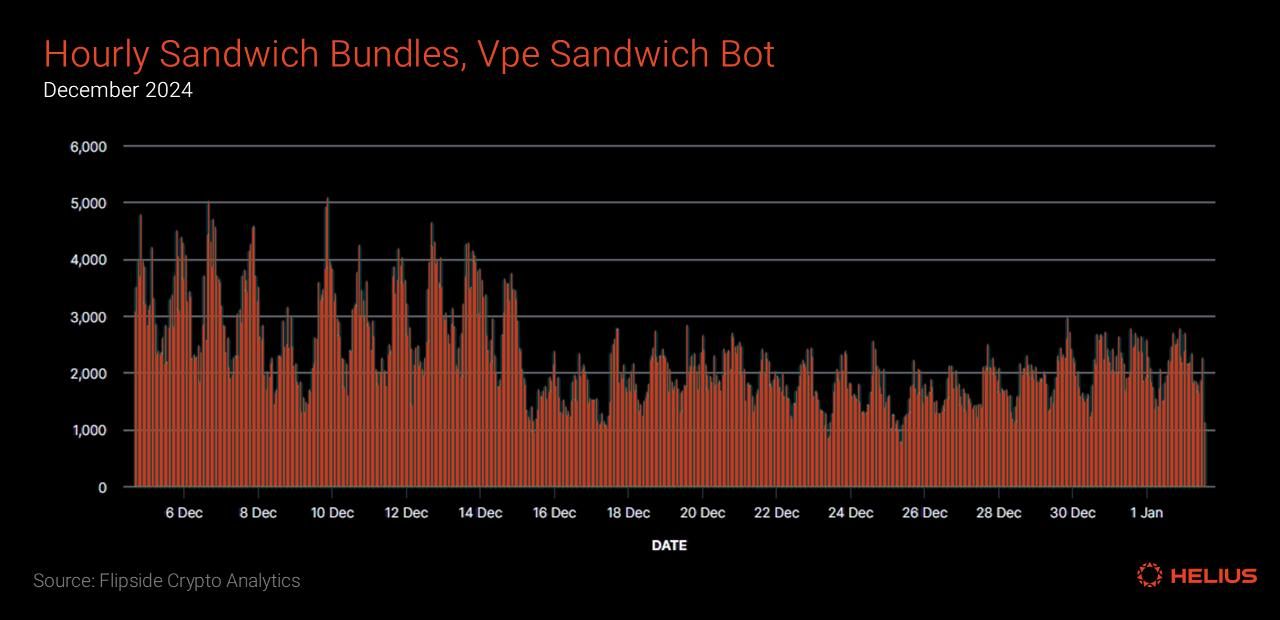
Above: The number of sandwich transaction bundles initiated by the Vpe sandwich transaction program every hour (data source: Flipside crypto analytics, Marqu)
Jito’s internal analysis suggests that almost half of the sandwich attacks against Solana can be attributed to this program.
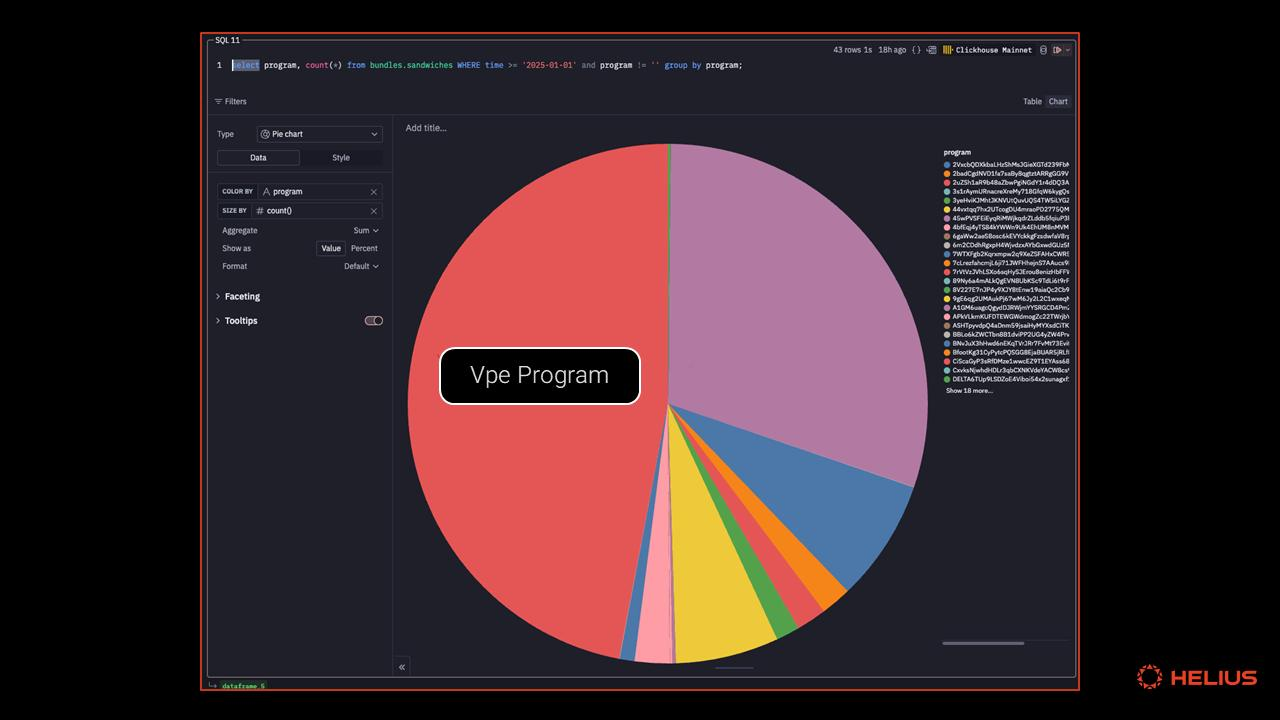
Above: The Vpe program is the source of nearly half of Solana’s sandwich attacks (Source: Jito internal)
During a 30-day period (December 7 to January 5), the program executed 1.55 million sandwich trades, an average of about 51,600 trades per day, with a success rate of 88.9%. The program generated a profit of 65,880 SOL ($13.43 million), equivalent to about 2,200 SOL per day. The Jito tips paid by the program totaled 22,760 SOL ($4.63 million), an average of about 758 SOL per day, and an average profit of 0.0425 SOL ($8.67) per sandwich trade.
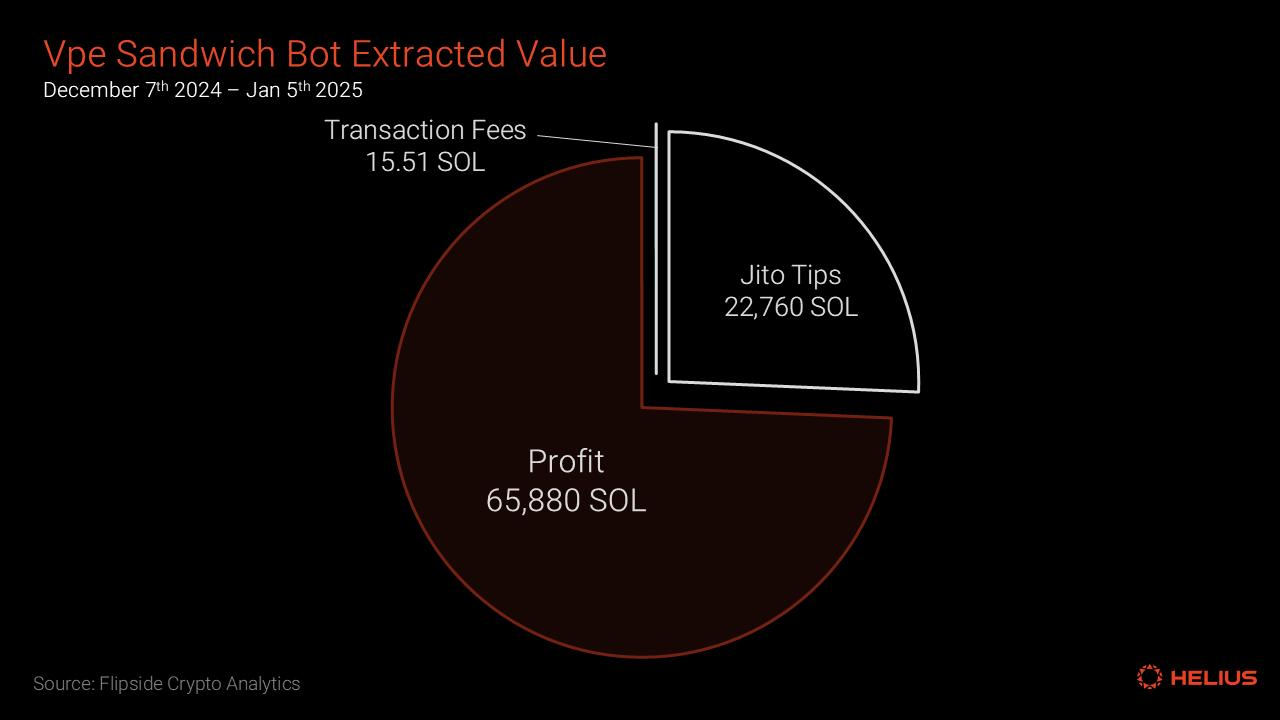
Above: Value extracted by the Vpe Sandwich trading bot from December 7, 2024 to January 5, 2025
Most of the compromised transactions involved exchanges through Raydium. Of the first 20 sandwich-attacked tokens, 16 were created on Pump Fun, which can be identified by token minting addresses ending in “pump.”
The Vpe Sandwich trading bot is one of many on-chain programs that perform sandwich attacks. Visit Sandwiched.me to see Sandwich attacks detected on Solana in real time.
Annualizing the December profit data, the program is expected to generate an annual profit of 801,540 SOL. In the worst case scenario of network centralization, if all of these profits are reinvested in the validators of the alternative memory pool, assuming that the overall network stake remains unchanged, their network stake share will increase by 0.2%.
However, this worst-case scenario is unlikely for several reasons. First, the network is currently experiencing near-record activity levels, and second, it is reasonable to assume that mempool searchers and operators will cash out some of their profits rather than reinvesting all of their earnings.
MEV Mitigation Mechanism
Significant resources have been invested in researching and exploring various mechanisms to mitigate or redistribute MEV. Generic, out-of-protocol solutions are increasingly being integrated into applications and infrastructure to minimize the scope of on-chain MEV, and these mechanisms are detailed below.
Validator Whitelist
One proposal is that stakers, RPC node providers, and other validators could exclude validators who are found to be performing sandwich attacks by ignoring their leadership slots. However, whitelisting is widely seen as a last resort. Assuming a leader is assigned four consecutive slots, this approach could delay transaction processing by several seconds, resulting in a poor user experience. More importantly, whitelisting has the potential to create a semi-permissioned and censored environment, which is in direct conflict with the blockchain industry's philosophy of decentralization. In addition, such a system also has the inherent risk of mistakenly excluding honest validators, which could undermine trust and participation in the network.
It is worth mentioning that some independent developers and applications are free to build their own validator allow or deny lists, such as the sendTransaction method in the Helius Node.js SDK.
Dynamic Slippage and MEV Protection
Traditionally, managing slippage has been a challenging and tedious process for users, who need to make manual adjustments based on the tokens they are trading. This approach is particularly cumbersome when dealing with volatile or less liquid tokens, as the slippage settings that apply to stable assets (such as liquid staking tokens or stablecoins) differ significantly from the slippage settings that apply to memecoins.
In August 2024, Jupiter Aggregator, the most popular retail trading platform on Solana, introduced Dynamic Slippage to address this complexity. This algorithmic mechanism uses a set of heuristic algorithms to optimize slippage settings in real time and calculate the ideal slippage threshold for each transaction. These heuristic algorithms consider factors such as:
Current Market Conditions
The type of token being traded (e.g. stablecoin pairs vs. more volatile memecoins)
The pool or order book through which the transaction passes
The user's maximum slippage tolerance
These heuristics ensure that trades are optimized to succeed with minimal slippage, thereby reducing the scope for MEV extraction.
MEV protection mode is becoming more and more common among decentralized exchanges and Telegram trading bots. When enabled, user transactions will be routed only to the Jito block engine, significantly reducing the risk of sandwich attacks. However, this protection comes at the cost of slightly higher transaction fees, so many Telegram bots will not choose to enable MEV protection even if it is provided. Because they are more focused on the rapid inclusion of transactions, prioritizing speed rather than reducing the risk of sandwich attacks.
Request for Quote System
RFQ (Request for Quote) systems are gaining traction on Solana, allowing professional market makers to fill orders rather than on-chain automated market makers (AMMs) or order books. These systems use signature-based pricing, allowing for off-chain calculations and price discovery, with only the final trade being recorded on-chain. Here are some examples:
Kamino Swap: An intent-based trading platform designed to eliminate slippage and MEV. Kamino utilizes the Pyth Express Relay to broadcast swap requests to a network of seekers, who bid on the trade to complete the transaction. The winning seeker offers the best execution price and pays a tip to the user. In the event of an arbitrage opportunity, the seeker may execute the trade at a better price than the request, generating a "surplus" on the trade. Users benefit by retaining any surplus on their trades, thereby increasing their overall execution value.
JupiterZ (Jupiter RFQ): Starting in December, all exchanges on Jupiter have JupiterZ enabled by default. This feature allows exchanges to automatically select the best price between Jupiter's standard on-chain routing engine and the RFQ system. With RFQ, users benefit from no slippage or MEV as trades are executed directly with off-chain market makers. Additionally, market makers incur trade priority fees and eliminate the need for complex routing logic.
RFQ systems work well for tokens that are widely traded on CEXs. However, they work less well for newer, less liquid, and more volatile on-chain assets. Unfortunately, these are precisely the trades that are most vulnerable to MEV attacks. Another downside is that liquidity is moved off-chain, reducing composability.
AMM that resists sandwich attacks
The sandwich-resistant AMM (sr-AMM) is an experimental design built on the traditional constant product model (xy=k) AMM. Its core is to use geometric formulas to automatically adjust the token prices in the funding pool.
sr-AMM uses slot windows to manage transactions. Transactions within a slot window have an asymmetric impact on the buy and sell order pools:
When a buy order is executed, the ask price on the pool rises along the xy=k curve, while the bid price remains unchanged, effectively increasing the liquidity on the buy side;
Conversely, sell orders consume this buy-side liquidity, thereby lowering the quote determined by the xy=k curve.
At the beginning of each new slot window, the sr-AMM resets to the equivalent xy=k state, recalibrating the bid and ask prices. By decoupling these resets from individual transactions and maintaining consistent pricing within each slot window, the sr-AMM undermines the atomic execution required for sandwich attacks, rendering them ineffective.
However, sandwich attacks are still possible at the boundaries between slot windows. If the leader controls consecutive slot windows, they can perform a front-run and target transaction at the end of the first slot window, and then perform a tail-run at the beginning of the next slot window.
In November of this year, Ellipsis Labs released Plasma , an audited reference implementation of a sandwich-resistant AMM design.
Conditional Liquidity and Order Flow Segmentation
Decentralized exchanges (DEXs) currently lack a mechanism to apply variable pricing to different types of market participants. This limitation stems from the inability of DEXs to accurately identify the costs of order flow to the DEX protocol. DEXs will narrow spreads to attract order flow, but inadvertently increase their risk of adverse selection from sophisticated buyers.
Conditional liquidity introduces a new mechanism that enables DEXs to dynamically adjust spreads based on the "expected toxicity" (expected malicious behavior or potential harmful effects) of incoming order flow. This enables DEXs to express a wider range of on-chain immediate preferences. Instead of offering a single spread to all participants, conditional liquidity enables DEXs to present a gradient of spreads that is calibrated based on the perceived likelihood of adverse selection by a particular taker.
This process relies on a new class of market participants, Segmenters. Segmenters specialize in assessing the "toxicity" of order flow and adjusting spreads accordingly. They receive a portion of the adjusted spread as compensation while passing the remainder to wallets or traders. By managing the responsibility for setting spreads, Segmenters enable DEXs to better compete for non-toxic order flow. Segmenters compete with each other to minimize the risk of adverse selection of liquidity providers. The tightest quotes are reserved for flows that are deemed least likely to harm liquidity providers. In the simplest form, a wallet or application can act as a segmenter for its own order flow. Alternatively, it can delegate the responsibility for flow segmentation to the market.
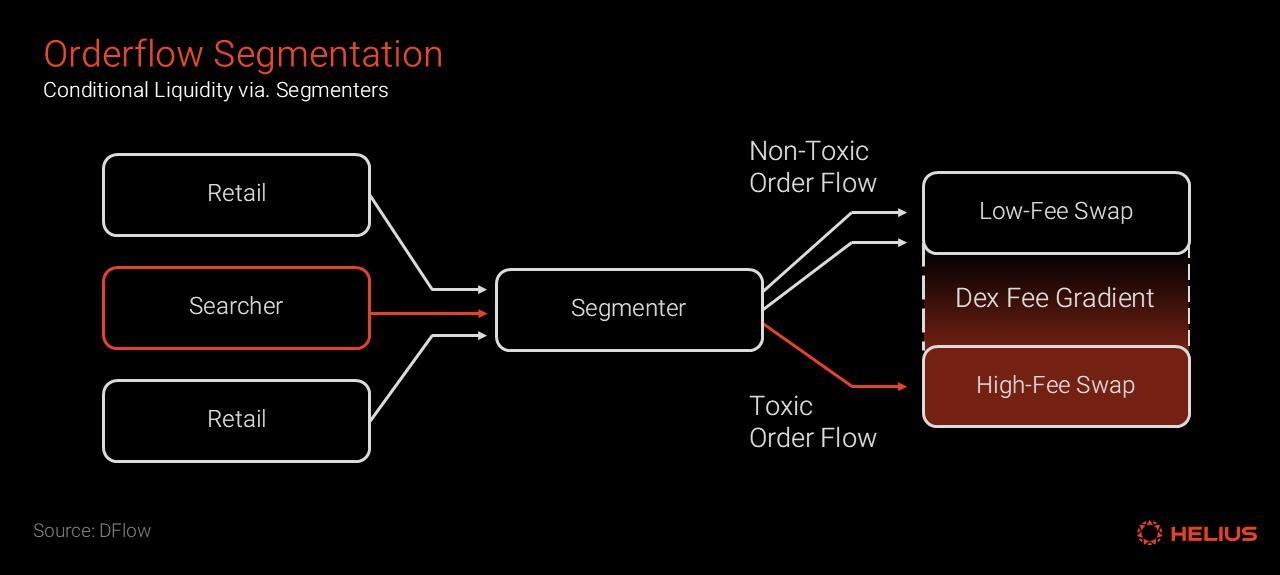
Users take advantage of this through “declarative swaps,” which enable them to declare their intention to swap and leverage sub-stakeholders to execute. These swaps interact with existing Solana liquidity sources and DEXs that enable conditional liquidity. Declarative swaps built with the Jito bundle provide traders with guaranteed quotes at the time of signing, while recalculating the best route before the trade enters the network, ensuring that the initial quote is respected.
This approach significantly reduces the latency between routing calculations and trade finalization, mitigating slippage. Additionally, when routed through a conditional liquidity-enabled DEX, declarative swaps minimize the potential for sandwich attacks. By providing tighter spreads for non-toxic flows, these DEXs improve trading conditions for Solana users. As a result, declarative swaps provide traders with the ability to reduce slippage, lower latency, and increase protection against sandwich attacks, resulting in a more efficient and secure trading experience.
Paladin
Paladin-Solana is an improved version of the Jito-Solana validator client that includes Paladin Priority Port (P3) transactions in the bundle phase by introducing a minimal code patch (about 2000 lines of code). Paladin Priority Port (P3) facilitates the processing of high-priority fee transactions. Validators act as leaders to open this fast lane, allowing them to process valuable transactions in a timely manner. Each P3 transaction meets the minimum fee threshold (10 lamports per computational unit) and is passed directly to the packaging phase to be processed in the order received.
Paladin prioritizes high-priority fee transactions and proactively identifies and discards sandwich transaction bundles based on transaction patterns. While this may initially appear detrimental to validator rewards, Paladin validators can be compensated through a trust-based mechanism. Validators that avoid sandwich attacks can attract direct transactions, creating an ecosystem of trust and increasing returns.
Validators are incentivized by the prospect of receiving additional rewards and by relying on the trust of P3 fast track users. However, if they include sandwich transaction bundles in their blocks, they risk losing P3 transaction revenue. This trust is collateralized with PAL tokens.
The PAL token is designed to align the interests of validators, users, and the broader Solana community. It has a fixed supply of 1 billion tokens, 65% of which will be allocated to validators and stakers, and the rest will be distributed between Solana builders, the Paladin team, and a development fund. Validators can lock PAL to enable P3 transactions on their nodes, creating a decentralized, permissionless, and token-controlled mechanism for MEV extraction and transaction prioritization.
The project is still in its early stages and has yet to reach critical mass for widespread adoption. Currently, there are 80 validators running Paladin, representing 6% of the network’s stake. Paladin claims to increase block rewards by 12.5%.
Multiple concurrent leaders system
Block producers maintain a monopoly on transaction inclusion within their assigned slots. Even if the current leader is known to be malicious and conducts a sandwich attack, users will be unaware, submit transactions and expect them to be processed immediately. Users cannot choose which node processes and orders transactions, which makes them vulnerable to manipulation.
The Multiple Concurrent Leaders (MCL) system introduces competition between block producers in the same period. Users gain the ability to choose a leader without incurring delays. If leader A is malicious and known to perform sandwich attacks, the user or application can choose to submit the transaction to leader B, which behaves honestly.
Maximizing the competition between leaders in the long term involves shortening the duration, limiting the number of consecutive slots a single leader is assigned, and increasing the number of concurrent leaders per slot. By scheduling more leaders per second, users gain greater flexibility, enabling them to choose the most favorable offer from the available leaders to trade with.
Although MCL offers a compelling long-term solution to address MEV, its implementation is complex and may require years of development.
Asynchronous execution (AE) is another potential way to reduce MEV. Under AE, blocks are built without executing or evaluating the outcome of each transaction. This speed poses a significant challenge to algorithms in calculating profitable opportunities and executing effective sandwich strategies in a timely manner.
in conclusion
Solana’s MEV landscape is evolving rapidly and is far from a stable competitive equilibrium. Seekers continue to explore more complex strategies to capture value, while the ecosystem deploys a diverse set of infrastructure and mechanisms to mitigate the impact of harmful MEV. Forward-looking ecosystem investors such as Multicoin Capital are actively deploying funds, believing that the value that ecosystem teams gain from Solana MEV will grow significantly, and that this value distribution landscape will change significantly in the coming years.
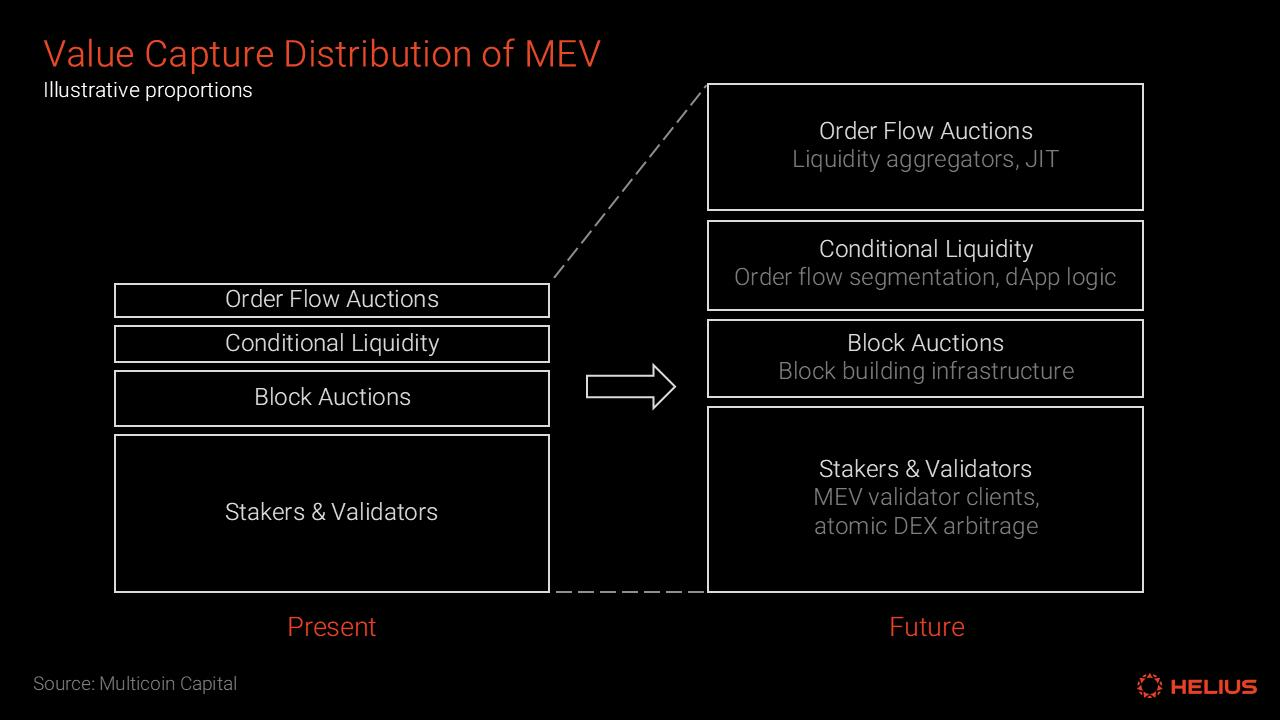
Above: MEV’s value capture distribution (Source: Multicoin Capital, Tushar Jain)
MEV is an unavoidable challenge for any blockchain that hosts significant financial activity. Properly addressing and managing this "MEV demon" is critical to the long-term success of the network. Solana has undoubtedly emerged stronger from the difficulties in 2023 and is now a highly active blockchain with growing user adoption. However, new challenges lie ahead. In order to achieve wider adoption, the ecosystem must face these challenges head-on. Solana is currently at a critical juncture in its development, which is both a challenge and a valuable opportunity to define its future.





